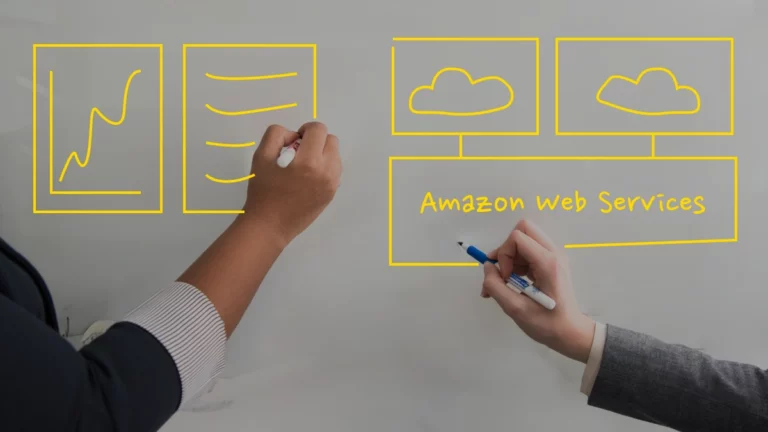AWS vs Azure Security Comparison: A Guide for Business
- AWS Service Security Overview
- Azure Information Protection Overview
- AWS Security vs Azure Security:Services, Tools & Main Features
- Azure Security vs AWS Security: Compliance and Certification
- Cloud Security Comparison: Cost-Effectiveness of AWS and Azure Security
- Choosing the Right Platform for Your Business Needs
- Best Practices for Enhancing Cloud Security
- Conclusion
Today businesses of all sizes – from startups to mid-size and enterprise-grade companies – increasingly rely on cloud platforms to support their operations. And here comes a critical concern: security. Both Amazon Web Services (AWS) and Microsoft Azure are known for their focus on data protection and security, robust infrastructures, and feature-rich ecosystems. Azure or AWS? It may be challenging to choose the right one for your project. Business owners and decision-makers need a full understanding of how their security measures work, as they impact the safety and compliance of their data, applications, and workflows.
While Azure and AWS offer strong user data protection, this is achieved through different frameworks, sets of tools, and general approaches. AWS, the world’s first major cloud service provider, understandably has the most years of experience, backed with a comprehensive set of security features. Its shared responsibility model, advanced encryption, threat detection, and global compliance capabilities make it a popular choice for projects looking for scalability and flexibility without compromising security.
Azure, on the other hand, leverages Microsoft’s enterprise expertise, offering integrated security solutions that work seamlessly with its suite of productivity tools (Office 365 and Dynamics 365). It has a strong focus on security in hybrid environments and identity management, becoming an ideal solution for businesses that need a highly interoperable cloud environment.
AWS has been a dominant player in the cloud market for several years – leading to a substantial pool of AWS-certified professionals and a higher number of AWS engineers available in the job market, compared to Azure. However, the rapid growth of Azure is also driving increased demand for Azure skills, leading to a narrowing gap between the two.
Salaries of AWS and Azure engineers can vary: the world’s highest rates are found in the U.S., compensations in the EU differ depending on the country. Eastern Europe (Ukraine, Poland, Romania) offer the most affordable yet high-quality talents. For example, many companies have been using our staffing solutions, eventually benefitting from a 2x more cost-effective development.
Both AWS and Azure offer tools and services to address security challenges. Still, their approaches differ in areas like identity and access management (IAM), threat protection, compliance certifications, and support for hybrid / multi-cloud setups.
Whether you’re a startup choosing your first cloud provider or an enterprise evaluating a multi-cloud strategy, knowing data security capabilities of both platforms is essential to make a fully informed decision. This article is intended to give you a clear understanding of how AWS and Azure platforms stack up against each other and which one can align better with your specific security needs.
AWS Service Security Overview
As a pioneer in cloud computing, AWS also emphasizes scalability and flexibility, providing businesses with a vast array of security services that cater to a wide range of use cases. This platform shows its strongest benefits in areas like granular identity management, customizable threat detection, scalability, and third-party integrations.
Identity and Access Management (IAM)
Identity and Access Management makes it possible to control access to their resources with fine-grained permissions. The main layers of protection include features like Multi-Factor Authentication (MFA), access keys, and role-based access control. AWS uses Amazon IAM to ensure only authorized users can access sensitive data.
Data Protection & Encryption
AWS has end-to-end encryption for transferred data and data stored in the cloud. Services like Key Management Service (KMS) allow businesses to manage their encryption keys securely. For workloads requiring enhanced security, AWS CloudHSM offers hardware-based key storage. Storage and database tools Amazon S3 and RDS also support encryption.
Threat Detection
GuardDuty service uses Machine Learning to detect anomalies and unauthorized activities, while AWS Shield offers protection against Distributed Denial of Service (DDoS) attacks. The Web Application Firewall and AWS Inspector help protect web applications from common vulnerabilities, for example, SQL injection and cross-site scripting.
Compliance
There is an impressive range of certifications, including ISO 27001, GDPR, HIPAA, SOC 1/2/3, and PCI DSS. This demonstrates AWS’s commitment to meeting global regulatory standards – making it a good fit for projects operating across multiple geographies.
Security
Supporting hybrid and multi-cloud environments, AWS supports extending on-premises and network security practices to the cloud. Direct Connect and other tools in AWS provide secure connections between on-premises infrastructure and the AWS cloud, while AWS Outposts offers a hybrid cloud solution that combines cloud and on-premises infrastructure with AWS compatibility.
Amazon Virtual Private Cloud (VPC)
As a critical security feature of this platform, AWS VPC provides users with a logically isolated section of the AWS cloud where they can launch AWS resources within a defined virtual network. VPC enables businesses to gain full control over their networking environment, ensuring secure and flexible access to cloud resources. This is especially useful for enterprise apps, hybrid cloud architectures, and data-intensive workloads.
Unique Tools & Features
Scalability is one standout feature of AWS security. As the project grows, AWS security services can scale seamlessly to protect increasing amounts of traffic and data in the cloud. Tools like AWS Security Hub centralize security alerts and provide insights across multiple AWS accounts, simplifying security management for large projects and comprehensive operations.
Azure Information Protection Overview
Azure provides vast opportunities for organizations prioritizing an enterprise-friendly cloud environment. Known for its seamless integration with other Microsoft products and services (like Microsoft 365 and Dynamics 365), it offers a unified approach to security that extends across on-premises, hybrid, and cloud environments.
Identity and Access Management (IAM)
A core of Azure’s security is represented by its IAM capabilities built around Azure Entra ID (formerly Azure Active Directory) – a comprehensive identity platform that supports single sign-on (SSO), Multi-Factor Authentication (MFA), conditional access policies, and identity protection through AI-driven risk assessments across multiple applications and platforms.
Data Protection & Encryption
Data at rest is secured with Azure Disk Encryption, while data in transit is protected via Transport Layer Security (TLS). Azure also has Azure Key Vault, a secure repository for managing encryption keys, and passwords. Azure features for automatic data encryption are unique – Synapse Analytics and Transparent Data Encryption (TDE) for SQL Database.
Threat Detection
Microsoft Defender for Cloud (formerly Azure Security Center) provides unified threat management, offering tools for monitoring, vulnerability assessment, and compliance checks. Additionally, Azure Sentinel, a cloud-native Security Information and Event Management (SIEM) tool, delivers real-time threat detection, incident response, and advanced analytics powered by AI. Azure’s DDoS Protection is another key feature to safeguard applications.
Compliance
Being one of the strongest areas of Azure, compliance is supported by GDPR, HIPAA, ISO 27001, FedRAMP, SOC 1/2/3, and PCI DSS, among others. Microsoft has made significant investments to meet global, regional, and industry-specific regulatory requirements – making it an ideal choice for highly regulated industries (healthcare, finance, government, etc.).
Security
Azure resources are particularly well-suited for hybrid and multi-cloud environments. Its Azure Arc service allows businesses to extend data protection and governance capabilities to on-premises and multi-cloud resources, providing consistent management and monitoring. Azure uses ExpressRoute to facilitate secure and private connections between on-premises infrastructure and Azure, ensuring low-latency and highly secure communication.
Azure Virtual Network (Azure VNET)
This foundational networking service provides a secure and isolated controllable environment to run Azure resources. VNet makes it possible to build highly customizable virtual networks that integrate seamlessly with on-premises infrastructure and other Azure services. It is a critical tool for cases like enterprise-grade applications, disaster recovery, managing IoT solutions at scale, and hybrid deployments.
Unique Tools & Features
Integrating security with productivity tools is one standout feature of Azure security. Companies already using other Microsoft applications benefit from Azure’s seamless security integration, allowing for a unified user experience across platforms. It also has tools to help businesses avoid common issues: Azure Policy (for defining and enforcing organizational standards), Security Benchmark (providing a comprehensive set of guidelines), and Azure Advisor (offering tailored recommendations). Additionally, this platform has centralized security management and monitoring through Azure Lighthouse and Azure Monitor.
AWS Security vs Azure Security:
Services, Tools & Main Features
When comparing AWS and Azure security, both platforms have powerful, enterprise-grade services designed to protect cloud workloads, as highlighted in Gartner’s Cloud Security Insights. However, their approaches, tools, and features differ in ways that can significantly influence your choice, as shown in the table below.
| Category | AWS | Azure |
| Identity and Access Management | AWS IAM for granular control over user permissions and policies, with tools like MFA and temporary credentials | Azure Entra ID (Azure AD) for SSO, MFA, conditional access policies, and advanced identity protection using AI-driven risk assessments |
| Encryption | End-to-end encryption with AWS Key Management Service (KMS) and hardware-based encryption via AWS CloudHSM | Encryption with Azure Key Vault, disk encryption with BitLocker, and secure data processing through confidential computing with secure enclaves |
| Threat Detection | Amazon GuardDuty detects anomalies using machine learning, AWS’s Shield protects against DDoS attacks, AWS WAF secures web applications | Microsoft Defender for Cloud for unified threat management, Azure Sentinel for advanced threat detection and response with AI and ML |
| Cloud Security (Hybrid) | AWS Outposts, AWS Direct Connect, and Amazon VPS for secure hybrid setups, but hybrid support is less seamless compared to Azure | Azure Arc, Azure Stack, Azure ExpressRoute for robust security and governance across on-premises, hybrid, and multi-cloud environments |
| Compliance | Certifications for GDPR, HIPAA, SOC 1/2/3, PCI DSS, and more, meeting global regulatory standards | Certifications for GDPR, HIPAA, FedRAMP, ISO 27001, and others, with a particular focus on government and highly regulated industries |
| Pricing Models | Security tools and services are priced separately, offering flexibility but potentially higher costs as features are added | Bundled pricing for tools, such as Microsoft Defender for Cloud, providing cost predictability for enterprise customers |
| Integration | Integration with numerous third-party security tools, allowing flexibility in building customized stacks | Seamless integration with Microsoft products, offering a unified enterprise experience |
| DDoS Protection | AWS’s Shield Standard is free, with advanced protection through its Advanced service at an additional cost | Azure DDoS Protection Standard offers similar services but is integrated directly with Azure’s cloud-native services |
| Compliance Monitoring | AWS Config and AWS Security Hub for centralized monitoring for compliance and security best practices. | Azure Policy and Azure Security Benchmark for enforcing compliance standards and detailed reporting on compliance / security posture |
| Scalability | Highly scalable tools suitable for global enterprises and rapidly growing businesses | Equally scalable, with a strong focus on centralized management and governance for hybrid and multi-cloud setups |
| Ease of Use | May require more technical expertise to fully configure and optimize advanced features | User-friendly interfaces, especially for organizations already familiar with Microsoft ecosystems |
| Regional Availability | 30+ regions globally, offering consistent security and compliance across regions | 60+ regions, with strong regional compliance and data sovereignty capabilities |
| Zero Trust Model | Security best practices emphasized, but without a fully integrated Zero Trust security model | Microsoft’s Zero Trust model ensures comprehensive security across users, devices, and applications |
| Backup and Recovery | Automated Backup solutions through AWS Backup for databases, storage, and applications | Robust backup and disaster recovery via Azure Backup, with integration into other Azure services, such as Azure Site Recovery / Azure Storage / Azure Blob Storage |
Azure Security vs AWS Security: Compliance and Certification
Both platforms have achieved extensive compliance certifications to meet global, regional, and industry-specific regulatory requirements (GDPR, HIPAA, ISO 27001, SOC 1/2/3, PCI DSS, and others). AWS offers a broad range of compliance certifications, adhering to frameworks like the NIST Cybersecurity Framework, with a focus on global consistency. Azure highlights certifications tailored for enterprise and hybrid environments – and often goes deeper into specific industry standards.
| Category | AWS | Azure |
| Government Compliance | FedRAMP Moderate and High, ITAR, and support for CJIS and DoD requirements in specific regions | FedRAMP High and Moderate, DISA SRG Levels 2-5, ITAR, comprehensive CJIS compliance (U.S.) |
| Industry-Specific Certifications | HITRUST CSF, FINRA compliance for financial services, and more | HITRUST CSF, MTCS Singapore for financial services, and compliance with healthcare and education standards. |
| Global Coverage | 30+ regions globally, consistent compliance across geographies | 60+ regions globally, stronger regional compliance and data sovereignty |
| Cloud Compliance (Hybrid) | AWS Outposts supports hybrid environments but with limited compliance compared to Azure | Azure Arc and hybrid solutions are fully compliant with the same standards as Azure’s cloud platform |
| Certification Updates | Regularly updated to match evolving regulations globally | Aggressive updates, often leading the market in aligning with new compliance frameworks. |
| Audit and Reporting Tools | AWS Artifact provides self-service access to audit reports and compliance documentation | Azure Compliance Manager offers customizable compliance assessments and real-time tracking |
| Customer Responsibility Tools | AWS Config and AWS Well-Architected Tool help ensure meeting compliance responsibilities | Azure Policy and Blueprints enforce compliance with predefined standards and customer policies |
Cloud Security Comparison: Cost-Effectiveness of AWS and Azure Security
Both platforms have flexible pricing models, enabling you to pay only for what you use. AWS resources offer a modular approach, making it possible to choose and pay for specific features (though this can eventually lead to higher costs for comprehensive setups). Azure often bundles tools into broader offerings and seamless integrations, potentially saving costs if you’ve already invested in the Microsoft ecosystem. Consider the following key factors.
| Category | AWS | Azure |
| Pricing Model | Pay-as-you-go for individual services with flexibility but potentially higher overall costs | Bundled pricing for security tools (e.g., Microsoft Defender for Cloud), more predictable costs |
| Free Security Features | AWS’s Shield Standard (DDoS protection) and basic IAM features available at no additional cost | Free tier features like Azure Security Center (basic) and Azure Active Directory Basic available |
| Threat Detection Costs | Amazon GuardDuty costs based on the volume of logs processed, potentially increasing with usage | Microsoft Defender for Cloud charges per resource protected, offering competitive pricing for bundles |
| Encryption Services | AWS KMS is priced per key and API request, with additional costs for HSM services, such as AWS CloudHSM | Azure Key Vault charges per operation and storage, with comparable costs to AWS KMS |
| DDoS Protection Costs | AWS’s Shield Advanced requires an additional subscription fee for enhanced protection | Azure DDoS Protection Standard charged per resource but often integrates with existing cloud services |
| Compliance Tools | AWS Artifact is free, while AWS Config and Security Hub incur additional costs for monitoring | Azure Compliance Manager included in broader compliance tools, with no standalone cost |
| Scaling Costs | Costs scale with increased usage of resources and additional security services | Costs scale similarly but may benefit from bundled enterprise solutions, reducing incremental spending |
| Hybrid Cloud Security | AWS Outposts and related tools for hybrid environments can add significant costs | Azure Arc includes hybrid security as part of broader Azure services, often more cost-efficient |
| Integration Costs | Third-party integrations can add costs, as AWS emphasizes flexibility | Native integrations with Microsoft 365 and Dynamics reduce spending on third-party tools |
| Support Costs | Tiered support plans available, with security support starting at a percentage of monthly AWS charges | Similar support tiers, but integrates support with Microsoft enterprise agreements |
Choosing the Right Platform for Your Business Needs
To choose the right cloud resources you need to carefully analyze your business needs, current infrastructure, and long-term goals. Whether it’s AWS with its unmatched scalability and flexibility, or Azure with its enterprise-focused, hybrid-friendly solutions – the decision should align with your project’s priorities. Breaking the process into clear steps will help you make the right decision.
Step 1: Assess Your Business Requirements & Compliance Needs
List the primary needs of your project. Are you prioritizing cost savings, scalability, data protection, or compliance?
If you’re in a global industry, AWS may suit due to its consistent compliance strengths. At the same time, Azure offers broad industry-specific compliance coverage, making it ideal for highly regulated and government-related sectors.
Step 2: Analyze Existing Tech Investments & Long-Term Goals
Review your tech stack. Is AI, IoT, or real-time data processing a priority? Think about your project’s future.
If you already use Microsoft tools like Office 365 or Dynamics 365 – Azure will integrate seamlessly, saving time and resources during migration. If you rely on third-party solutions, AWS’s flexibility might be advantageous, and this platform is better suited for innovation-driven growth and emerging technologies.
Step 3: Review Pricing Models, Hybrid / Multi-Cloud Capabilities
Pick the platform that aligns best with your cloud strategy. Remember that each has different pricing models.
AWS operates on a pay-as-you-go basis, offering flexibility but potential cost variability. Azure usually has bundled pricing, better for businesses heavily invested in Microsoft services. For a hybrid or multi-cloud strategy, AWS Outposts and multi-cloud integrations would be better (but may still involve higher costs for comprehensive solutions).
Step 4: Consider Security Priorities, Level of Support & Resources
Identify your key security concerns (data protection, identity management, threat detection). Evaluate available support and resources.
Comparing Azure security vs AWS security, Azure emphasizes comprehensive, built-in features, especially for hybrid environments. It offers enterprise-grade support with tight integration into Microsoft’s ecosystem, making things easier if you’re already using their tools. On the other hand, AWS offers granular security tools with better customization for specific needs. With extensive third-party integrations available, it may require specialized expertise to manage.
Best Practices for Enhancing Cloud Security
Implementing the right practices ensures your data and infrastructure remain secure, compliant, and resilient to evolving threats. Here’s a quick list for enhancing cloud security – by combining these practices with AWS or Azure’s built-in tools, you can create a secure cloud environment tailored to your specific needs.
- Adopt the principle of least privilege. Limit user access to only the resources and data necessary for their roles / responsibilities to minimize potential breaches, as recommended by the Cloud Security Alliance.
- Enable multi-factor authentication (MFA). You can improve account security by setting up additional authentication steps beyond just passwords.
- Introduce and enforce security policies. Establish clear policies for cloud usage, ensuring alignment with compliance standards and the project needs.
- Implement continuous monitoring & threat detection. Use AWS GuardDuty, AWS Cloudwatch or Azure Security Center to monitor activity, detect anomalies, and respond to threats in real-time.
- Deliver regular updates and system patches. Make sure to keep your cloud infrastructure always up to date to mitigate vulnerabilities from outdated software or services.
- Don’t forget about data encryption. You should protect sensitive information with encryption protocols to ensure compliance and data protection.
- Conduct regular audits. Set a schedule to periodically review your policies and configurations to identify potential issues and address gaps early.
Conclusion
When comparing AWS and Azure, it’s clear that both platforms have powerful security solutions tailored to diverse business needs. In a nutshell, AWS excels in scalability, global reach, and flexibility – while Azure is more advantageous if you’re looking for seamless integration with Microsoft tools and strong hybrid cloud capabilities. AWS or Azure? The choice between Azure security vs AWS security depends on your specific priorities, such as compliance requirements, budget constraints, and technical infrastructure.
Navigating the complexities of cloud security can be daunting, but you don’t have to do it alone. At Mobilunity, we specialize in supporting clients with the best-in-class AWS / Azure cloud engineers and tech consultants – or can even build the whole dedicated software development team from scratch. Whether you’re creating a secure cloud infrastructure, optimizing your existing environment, or integrating advanced security practices – we can help you boost your project with skilled specialists who have successfully solved your type of challenges.













